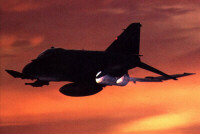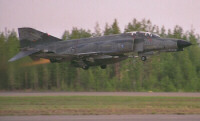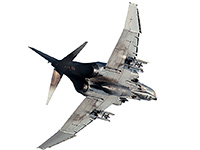McDonnell F-4 Phantom II
Role: fighter, fighter-bomber, recce, SEAD
Company: McDonnell Aircraft (McDonnell Douglas, Boeing)
Variants: F-4A (F4H-1F), F-4B (F4H-1), F-4C (F-110A), F-4D, F-4E, F-4E(S),
F-4EJ, F-4F, F-4G, F-4J, F-4K (FG.Mk 1), F-4M (FGR.Mk 2), F-4N, F-4S, EF-4C, RF-4B, RF-4C, QF-4B, QF-4J, QF-4S, QF-4E, QF-4G, QRF-4C
Operators*: US Air Force, US Navy, US Marine Corps, Germany, United Kingdom,
Turkey, Greece, Spain, Egypt, Iran, Israel, Australia, Japan, South Korea
* past and present
The F-4 Phantom II was a twin-engine, all-weather, fighter-bomber with a crew of two. The aircraft was originally designed as a fighter interceptor for US Navy fleet defense but was also adapted for the air superiority, interdiction and close air support roles. More than 5000 Phantoms were built and it is still flown today. The F-4 was the first naval fighter without internal guns or cannons, relying on a combination of semi-active radar guided AIM-7 Sparrow and short-range heat-seeking AIM-9 Sidewinder missiles. It was the first fighter equipped with pulse Doppler radar with look-down and shoot-down capability. So it could find and destroy enemy aircraft in the F-4's radar range using missiles without having to rely on ground control to be intercept targets. Capable of carrying a heavy load of unguided air-to-ground ordnance, the Phantom was also used as fighter-bomber. Following the Vietnam experience that proved engagements would still involve into dogfights, first gun pods and later an internal gun was fitted. For the fighter-bomber role the aircraft gained air-to-surface missiles and precision guided munitions. The resulting F-4E variant was widely exported. Variants of the F-4 Phantom II also included dedicated photo reconnaissance versions. Adopting the SEAD/DEAD role, at the time better known as the Wild Weasel mission in the U.S. Air Force, the last U.S. production variant was the F-4G. By the turn of the century, the US Navy and USAF only used the optionally manned/ QF-4 drone conversion as full-scale aerial targets for exercises.
Outside of the United States armed forces, the German Luftwaffe was the biggest operator of the Phantom in Europe. Following the end of the Cold War, the F-4F remained in service in the air defense role and the fleet was upgraded under the ICE program gaining multi-mode radar and the AIM-120 active radar-guided air-to-air missile. In Europe, Turkey and Greece also upgraded their F-4E fighter-bombers with multi-mode radar and new weapons. The Greek Air Force (HAF) upgrade program known as Peace Icarus I&II covered 40 aircraft. Turkey's upgrade known as F-4E/2020 Terminator was carried out in cooperation with IAI, adding AGM-88 anti-radar capability and the AGM-142 stand-off air-to-surface missiles. Just like Spain and Israel before them, Greece and Turkey also held on to a small number of RF-4 photo reconnaissance aircraft.
Outside Europe, the F-4 saw extended service in South Korea, Japan and Iran. South Korea replaced the type with the F-15K. Japan put part of their F-4EJ fleet through a life extension upgrade. Finally, Iran is holding on to its ageing F-4s, unable to import a capable replacement with the embargoes due to its nuclear program. Unlike other aircraft in Iranian service, the air force and domestic industry has the expertise and experience with the F-4 to sustain a capable force able to carry out air-to-air or air-to-ground missions.




 Back to Index
Back to Index